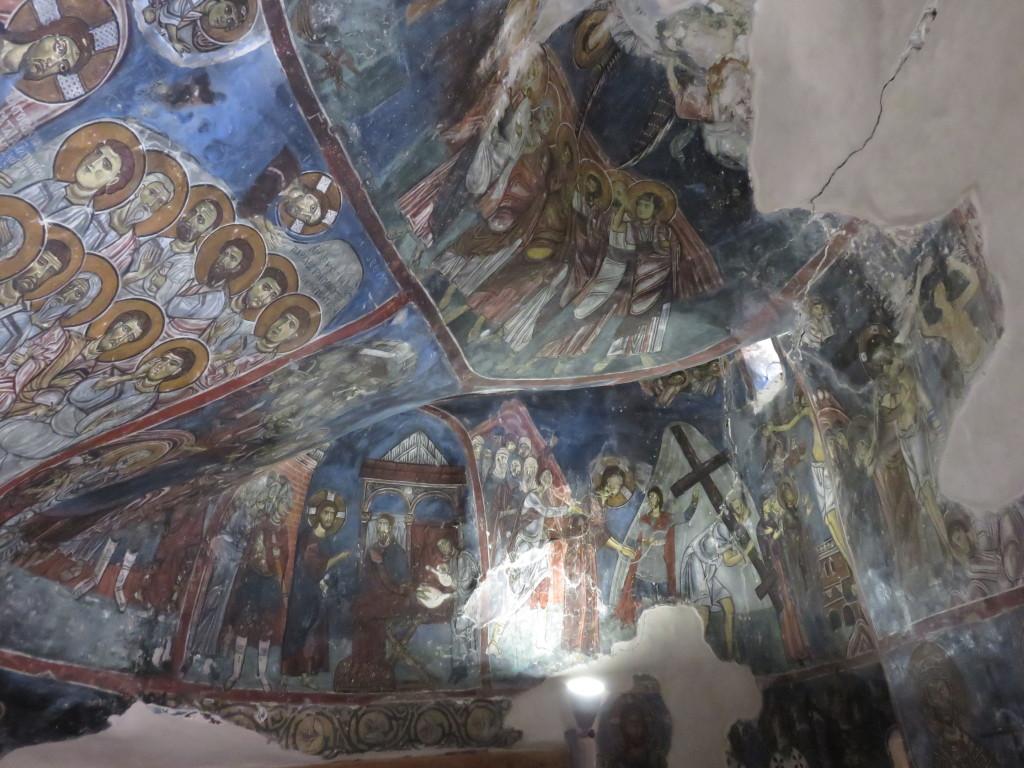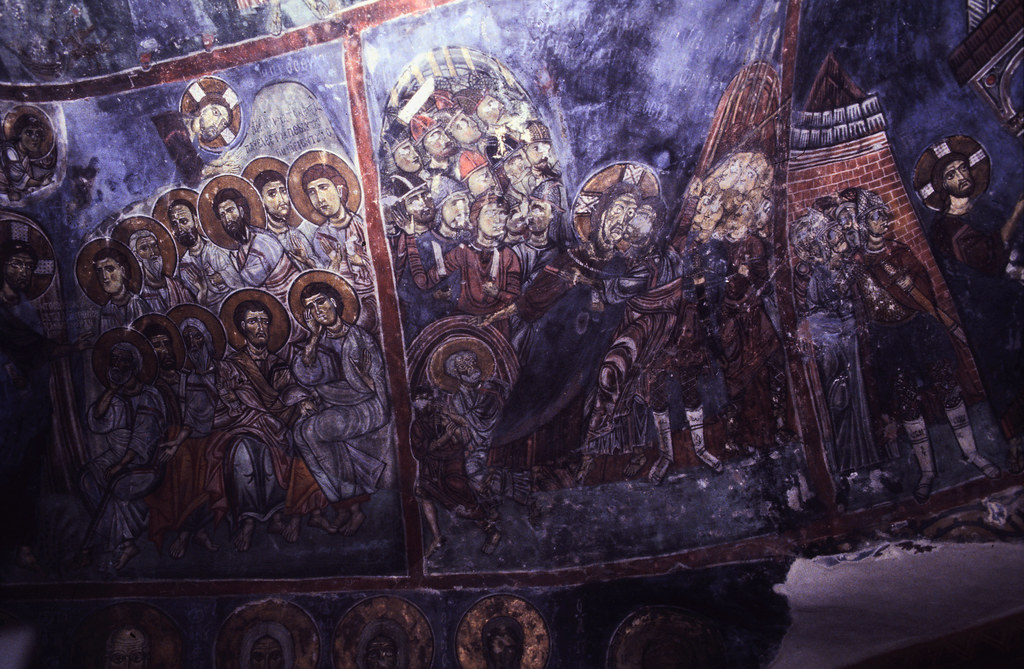Frescoes in the Enkleistra (cave church) of St. Neophytos, Paphos, Cyprus, 1182-1196AD

Looking into the Bema from the Naos. Painted by Theodoros Apsevdis.
Photo source: Cyprus: Saint Neophytos Monastery

A larger image of 'Jesus Betrayed by Judas', Byzantine Fresco in the Enkleistra (cave church) of St. Neophytos, Paphos, Cyprus, 1182-1196AD
Facing to the left relative to the 1st photo.
Photo by Rüdiger Stehn, August 1982
'Jesus before Pilate', Byzantine Fresco in the Enkleistra (cave church) of St. Neophytos, Paphos, Cyprus, 1182-1196AD
'Road to Calvary', Byzantine Fresco in the Enkleistra (cave church) of St. Neophytos, Paphos, Cyprus, 1182-1196AD
'Crucifixion', Byzantine Fresco in the Enkleistra (cave church) of St. Neophytos, Paphos, Cyprus, 1182-1196AD
Perhaps in the Naos: Soldiers in 'Jesus Heals the Lame', Byzantine Fresco in the Enkleistra (cave church) of St. Neophytos, Paphos, Cyprus, 1182-1196AD

Plan of the Enkleistra complex of St. Neophytos (Mango and Hawkins 1966).
Some red paint layers containing lead pigments and cinnabar have darkened to black.
Source: The Techniques and Materials of the Wall Paintings at the Enkleistra of St. Neophytos (Phase II) by Ioanna Kakoulli and Christian Fischer
According to written testimonies including an inscription by the painter, Theodore Apseudes, giving the date AD 1182/1183 and a statement by Saint Neophytos himself asserting: “in the twenty- fourth year of my confinement [1183] the Enkleistra was painted throughout (Mango and Hawkins, 1966, p.124), the date for the extended painted phase of the original nucleus of chambers has been established as AD 1182/1183, while, the final phase of the paintings (mainly in the naos) was attributed to a different and unknown painter around AD 1196.
"The Enkleistra of St. Neophytos" by Kakoulli et al, in Asbestos JAS 2014
Referenced as figure 231 in The military technology of classical Islam by D Nicolle
A - Christ before Pilate,
B - Crucifixion,
C - Road to Calvary,
D - The Betrayal,
c. 1200 AD, Byzantine, in situ, Hermitage of St. Neophytos, Enkleistra, Cyprus.

Referenced as figure 114 in Arms and armour of the crusading era, 1050-1350 by Nicolle, David. 1988 edition
114A-114F Wall-paintings, Crusader Kingdom of Cyprus, c.1200 A.D. (in situ Hermitage, St. Neophytos Monastery, Ktima, Cyprus)
114A—“Way of the Cross”;
114B—“Christ before Pilate”;
114C—“Centurion Longinus at the Crucifixion”;
114D—“Soldiers at Crucifixion”;
114E-114F—“Betrayal”.
The wall-paintings at St. Neophytos, perhaps because they are far from the Byzantine capital and might already be under some western European influence, seem much more realistic in their portrayal of arms and armour than most other Byzantine sources.
Short-sleeved full-length mail hauberks without coifs (114A) are shown, as are shorter mail shirts.
The latter style is generally thought to end at the waist but one figure at St. Neophytos seems to show the lower part of such a shirt or hauberk visible beneath a skirt or kilt (114D).
This is sometimes seen in Islamic sources (Fig. 455).
In other words, the mail shirts apparently worn over longer tunics in many Byzantine sources may in reality have been longer mail hauberks worn inside a skirt-like kilt.
The shield of Fig. 114C is a straightforward large kite-shaped type and the weapons in neighbouring pictures show standard spears, axes, swords and knives.
But the head defences are slightly more difficult.
The pointed outlines, brow rims and apparent combs of some which are apparently made of mail, plus the fact that they do not go beneath the wearer's chin,
suggest that rather than being true coifs they might represent a form of mail hood worn over or attached to a padded arming cap.
As such, they would approximate later Ottoman zirb külāb helmets of mail.
It is also possible that the artist has simply misunderstood a mail coif.
Proper helmets do appear (114F), most being of the war-hat or chapel-de-fer type.
They have brims and are made in two segments riveted to a central comb.
Such helmets would remain common in Byzantine art up to the late fourteenth century and almost certainly reflect standard Byzantine equipment.
They are shown either with mail aventails or worn over the previously discussed mail hoods.
[Fig 455 is Folio 29v, 'Maqamat' of al-Hariri, Bibliothèque nationale de France, manuscript Arabe 5847, 1237AD]
See also David and Goliath, Byzantine Psalter, Palestine or Cyprus, 12th century. BL Add MS 40753
Other 12th Century Illustrations of Costume & Soldiers




